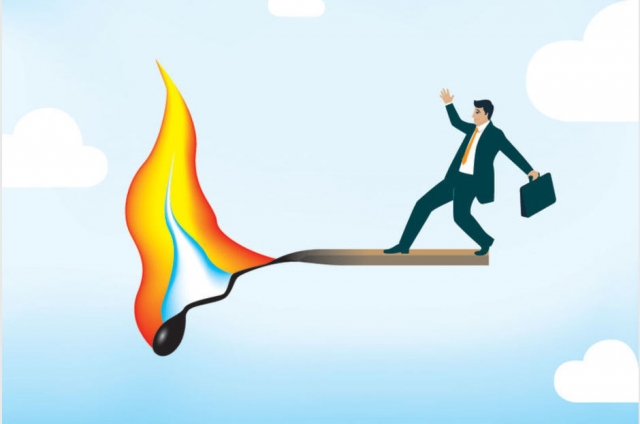Learning how to manage the multiple demands placed on you is an important part of managing your personal agency and guarding against burnout. Managing demands is sometimes as easy as saying no – and sometimes it’s more complicated.
Burnout
In the first blog in our series, Thrive, Don’t Just Survive, we first defined burnout as the perception that you cannot change your environment and thus have no personal agency (your ability to get things done). Burnout is frequently defined by exhaustion, cynicism, and inefficacy. It’s what happens when we feel we have depleted our personal agency. It’s when we feel like we don’t have any ability to make a change. While our results, the support we receive, and our self-care fill up our personal agency, demands drain us.
The Valve on Demands
It’s commonly overlooked, but there is a valve on the demands that drain us. We can say no, and we can manage our demands, so they don’t overly deplete our agency. Often, we forget that, just because someone wants something from us, doesn’t mean that we must give it.
We don’t have to join the PTA, host the neighborhood watch meeting, agree to work overtime, or any of the other dozens of things that may ask for our assistance. You can decline requests and save your ability to get things done for another situation or another cause to ensure you have enough reserves.
It gets harder when you need to say no at work to a peer, a manager, or someone on the team. The reasons for saying no are different. Some of the reasons for saying no are appropriate but have nothing to do with your need to manage personal agency. When things are wrong or you can’t agree, then no is the right answer. In business situations, after a polite no, it’s a good idea to start a dialogue about what is possible, whether your no is due to a disagreement or a need to maintain your agency.
When You Shouldn’t Say No
While it’s true that we can always manage our demands by saying no, there are times when this isn’t the right answer. Sometimes the right answer is to persist, meet your commitments, and decide how to manage your demands in the longer term. If there’s a crisis that your job requires you step into, it’s not a good time to say, “No, I don’t think I have the personal agency to support this.” As healthcare providers, we are frequently required to act urgently for our patients, even if the condition isn’t life-threatening. It’s incumbent on you to maintain reserves so that you can be ready for these circumstances.
The time to say no isn’t in a moment of crisis. The time to say no is when you’re planning your activities, when you’re making the decision to pick up that extra shift, fulfill that extra committee role, or take on an extra project. Once you’ve made the commitment to take care of a patient, you’re committed, whether you feel you have the capacity or not.
There are times when it feels like there is a gray area of what you can refuse and when you really cannot say no. Where do you turn for help if you are unsure if you have the right to refuse? Refer to your state’s Nurse Practice Act, your employer’s legal team and official policies, and Nursing Scope and Standards of Practice and Code of Ethics for Nurses.
Over Your Head
Just because you can’t say no in a moment of crisis doesn’t mean you shouldn’t ask for help – you absolutely should. It is important to remember that asking for help is not a sign of weakness. In truth, it is a sign of self-awareness and strength. Whatever your capacity in a crisis is, the answer isn’t to stand alone or tough it out. Instead, you should ask for support, so that you can share the load with others. The more help that you can get from others, the less you have to carry.
Of course, you should equally be willing to support others when they call for help – even if they’re not good at calling for help. Sometimes, supporting others means watching for situations where they may need help and proactively offering or providing support.
Learning how to manage the multiple demands placed on you is an important part of managing your personal agency and guarding against burnout. Managing demands is sometimes as easy as saying no – and sometimes it’s more complicated.
Burnout
In the first blog in our series, Thrive, Don’t Just Survive, we first defined burnouts as the perception that you cannot change your environment and thus have not personal agency (your ability to get things done). Burnout is frequently defined by exhaustion, cynicism, and inefficacy. It’s what happens when we feel we have depleted our personal agency. It’s when we feel like we don’t have any ability to make a change. While our results, the support we receive, and our self-care fill up our personal agency, demands drain us.
The Valve on Demands
It’s commonly overlooked, but there is a valve on the
demands that drain us. We can say no,
and we can manage our demands, so they don’t overly deplete our agency. Often, we forget that, just because someone
wants something from us, doesn’t mean that we must give it.
We don’t have to join the PTA, host the neighborhood watch
meeting, agree to work overtime, or any of the other dozens of things that may
ask for our assistance. You can decline
requests and save your ability to get things done for another situation or another
cause to ensure you have enough reserves.
It gets harder when you need to say no at work to a peer, a
manager, or someone on the team. The
reasons for saying no are different.
Some of the reasons for saying no are appropriate but have nothing to do
with your need to manage personal agency.
When things are wrong or you can’t agree, then no is the right answer. In business situations, after a polite no,
it’s a good idea to start a dialogue about what is possible, whether your no is
due to a disagreement or a need to maintain your agency.
When You Shouldn’t Say No
While it’s true that we can always manage our demands by
saying no, there are times when this isn’t the right answer. Sometimes the right answer is to persist,
meet your commitments, and decide how to manage your demands in the longer
term. If there’s a crisis that your job
requires that you step into, it’s not a good time to say, “No, I don’t think I
have the personal agency to support this.”
As healthcare providers, we are frequently required to act urgently for
our patients, even if the condition isn’t life-threatening. It’s incumbent on you to maintain reserves so
that you can be ready for these circumstances.
The time to say no isn’t in a moment of crisis. The time to say no is when you’re planning
your activities, when you’re making the decision to pick up that extra shift,
fulfill that extra committee role, or take on an extra project. Once you’ve made the commitment to take care
of a patient, you’re committed, whether you feel you have the capacity or not.
There are times when it feels like there is a gray area of
what you can refuse and when you really cannot say no. Where do you turn for help If you are unsure
if you have the right to refuse? Refer
to your state’s Nurse Practice Act, your employer’s legal team and official
policies, and Nursing Scope and Standards of Practice and Code of Ethics for
Nurses.
Over Your Head
Just because you can’t say no in a moment of crisis doesn’t
mean you shouldn’t ask for help – you absolutely should. It is important to remember that asking for
help is not a sign of weakness. In truth,
it is a sign of self-awareness and strength.
Whatever your capacity in a crisis is, the answer isn’t to stand alone
or tough it out. Instead, you should ask
for support, so that you can share the load with others. The more help that you can get from others,
the less you have to carry.
Of course, you should equally be willing to support others
when they call for help – even if they’re not good at calling for help. Sometimes, supporting others means watching
for situations where they may need help and proactively offering or providing
support.









